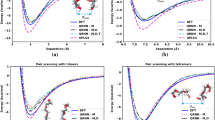Abstract
A central problem in modeling protein and other polymer structures is the generation of self‐avoiding chains which obey a priori distance restraint information which could include a folding potential function. This problem is usually addressed with a lattice model or a torsion space model of the polymer. Exhaustive searches in these spaces are of necessity exponentially complex. A new computer algorithm for modeling polymers and polymeric systems is described. This algorithm is a randomized algorithm based on a self‐assembling or Kohonen neural network. Given a defined chain topology, a defined spatial extent, and a prior probability distribution, it finds a set of coordinates which reproduce these properties. The convergence rate of the algorithm is linear with respect to the number of distance terms included. Modifications to the standard Kohonen algorithm to include a defined spatial metric, and a modified update rule improve the convergence of the standard algorithm and result in a highly efficient algorithm for building polymer models which are self avoiding and consistent with prior probability information and interatomic distance restraints.
Similar content being viewed by others
References
A. Achari, S.P. Hale, A.J. Howard, G.M. Clore, A.M. Gronenborn, K.D. Hardman and M. Whitlow, 1.67 Angstroms X-ray structure of the B2 immunoglobin binding domain of streptococal protein G and comparison to the NMR structure of the B1 domain, Biochem. 31 (1992) 10449.
T.C. Beulter and W.F. van Gunsteren, Molecular dynamics free energy calculation in four dimensions, J. Chem. Phys. 101 (1994) 1417–1422.
A.T. Brünger, G.M. Clore, A.M. Gronenborn and M. Karplus, Three-dimensional structure determination of proteins by molecular dynamics with interproton distance restraints: Application to Crambin, Proc. Natl. Acad. Sci. USA 83 (1986) 3801–3805.
T.H. Cormen, C.E. Leierson and R.L. Rivest, Introduction to Algorithms (McGraw Hill, New York, 1990) pp. 540–543.
J. De Vlieg and W.F. van Gunsteren, Combined procedures of distance geometry and molecular dynamics for determining protein structure from nuclear magnetic resonance data, Methods Enzymol. 202A (1991) 268–300.
R.W. Harrison, Stiffness and energy conservation in molecular dynamics: an improved integrator, J. Comp. Chem. 14 (1993) 1112–1122.
R.W. Harrison, D. Chatterjee and I.T. Weber, Analysis of six protein structures predicted by comparative modeling techniques, Proteins: Struct. Funct. Genet. 23 (1995) 463–471.
R.W. Harrison, C.C. Reed and I.T. Weber, Analysis of comparative modeling predictions for CASP2 targets 1, 3, 9 and 17, Proteins: Struct. Funct. Genet. Suppl. 1 (1997) 68–73.
J. Hertz, A. Krogh and R.G. Palmer, Introduction to the theory of neural computation, in: Santa Fe Institute Studies in Complexity Lecture Notes, Vol. 1 (Addison-Wesley, Redwood City, CA, 1991) pp. 244–246.
T. Huber and W.F. van Gunsteren, SWARM-MD: Searching conformational space by cooperative molecular dynamics, J. Phys. Chem. A102 (1998) 5937–5943.
T. Kohonen, Self-Organizing Maps, 2nd ed. (Springer-Verlag, Berlin, 1997).
A.K. Rappe, C.J. Casewit, K.S. Colwell, W.A. Goddard III and W.M. Skiff, UFF a full periodic table force field for molecular mechanics and molecular dynamics simulations, J. Am. Chem. Soc. 114 (1992) 10024–10035.
R. Rojas, Neural Networks (Springer-Verlag, Berlin, 1996) pp. 393–405.
I.T. Weber and R.W. Harrison, Molecular mechanics calculations on HIV-1 protease with peptide substrates correlate with experimental data, Protein Engrg. 9 (1996) 679–690.
I.T. Weber and R.W. Harrison, Molecular mechanics calculations on Rous sarcoma virus protease with peptide substrates, Prot. Sci. 6 (1997) 2365–2374.
Author information
Authors and Affiliations
Rights and permissions
About this article
Cite this article
Harrison, R.W. A self‐assembling neural network for modeling polymers. Journal of Mathematical Chemistry 26, 125–137 (1999). https://doi.org/10.1023/A:1019181811090
Issue Date:
DOI: https://doi.org/10.1023/A:1019181811090



